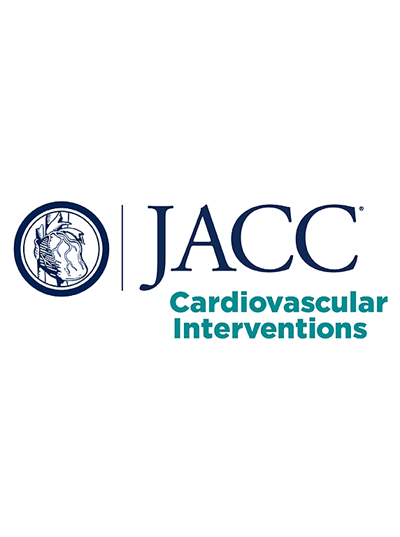多血管疾病和心源性休克的经皮冠状动脉介入治疗
IF 11.4
1区 医学
Q1 CARDIAC & CARDIOVASCULAR SYSTEMS
引用次数: 0
摘要
背景st段抬高型心肌梗死(STEMI)相关心源性休克和多血管疾病的最佳经皮冠状动脉介入治疗(PCI)策略仍不确定。目的:本研究的目的是探讨stemi相关心源性休克和多血管疾病的PCI策略与预后之间的关系。方法:这项多中心危险休克(丹麦-德国心源性休克)试验的探索性亚研究纳入stemi相关心源性休克和多血管疾病患者,不包括从心脏骤停复苏的昏迷患者。多血管病变定义为≥1个非罪魁祸首血管狭窄≥70%。排除孤立左主犯患者。在随机化前登记计划的PCI策略。所有分析均根据治疗后的PCI策略(即刻多血管PCI或仅罪魁祸首PCI)进行。主要终点为180天内的全因死亡率;次要结局包括肾脏替代治疗和急性肾损伤。结果在危险休克试验的355例患者中,221例(72%)患有多血管疾病;其中,118例(53%)行单纯PCI治疗,103例(47%)行即时多血管PCI治疗。PCI前SYNTAX (PCI与Taxus和心脏手术之间的协同作用)评分中位数分别为28 (Q1-Q3: 22-32)和29 (Q1-Q3: 22-34)。103例接受即时多血管PCI治疗的患者中有6例(6%)接受了慢性全闭塞PCI治疗。罪魁祸首组的全因死亡率为72 (61%;95% CI: 52%-70%),即时多血管PCI组的全因死亡率为52 (50%;95% CI: 41%-60%)(校正OR: 0.40; 95% CI: 0.19-0.83),中位随访时间为45天(Q1-Q3: 2-180天)。即时多血管PCI与次要结果无关。根据随机分配和PCI策略,无相互作用(P = 1.00)。结论与单纯PCI相比,即刻多支PCI的全因死亡率降低60%。本文章由计算机程序翻译,如有差异,请以英文原文为准。
Percutaneous Coronary Intervention in Multivessel Disease and Infarct-Related Cardiogenic Shock
Background
The optimal percutaneous coronary intervention (PCI) strategy in ST-segment elevation myocardial infarction (STEMI)–related cardiogenic shock and multivessel disease remains uncertain.
Objectives
The aim of this study was to investigate the association between PCI strategy and outcomes in STEMI-related cardiogenic shock and multivessel disease.
Methods
This exploratory substudy of the DanGer Shock (Danish-German Cardiogenic Shock) multicenter trial included patients with STEMI-related cardiogenic shock and multivessel disease, excluding comatose patients resuscitated from cardiac arrest. Multivessel disease was defined by ≥1 nonculprit angiographic stenosis ≥70%. Patients with an isolated left main culprit were excluded. The planned PCI strategy was registered before randomization. All analyses were performed according to as-treated PCI strategy (immediate multivessel PCI or culprit-only PCI). The primary outcome was all-cause mortality within 180 days; secondary outcomes included renal replacement therapy and acute kidney injury.
Results
Of 355 patients included in the DanGer Shock trial, 221 (72%) had multivessel disease; of these, 118 (53%) were treated with culprit-only PCI and 103 (47%) with immediate multivessel PCI. The median pre-PCI SYNTAX (Synergy Between PCI With Taxus and Cardiac Surgery) scores were 28 (Q1-Q3: 22-32) and 29 (Q1-Q3: 22-34), respectively. Chronic total occlusion PCI was performed in 6 of 103 patients (6%) treated with immediate multivessel PCI. All-cause mortality was 72 (61%; 95% CI: 52%-70%) in the culprit-only group and 52 (50%; 95% CI: 41%-60%) in the immediate multivessel PCI group (adjusted OR: 0.40; 95% CI: 0.19-0.83) over a median follow-up period of 45 days (Q1-Q3: 2-180 days). Immediate multivessel PCI was not associated with the secondary outcomes. There was no interaction according to randomization allocation and PCI strategy (P = 1.00).
Conclusions
Immediate multivessel PCI was associated with 60% lower odds of all-cause mortality compared with culprit-only PCI.
求助全文
通过发布文献求助,成功后即可免费获取论文全文。
去求助
来源期刊

JACC. Cardiovascular interventions
CARDIAC & CARDIOVASCULAR SYSTEMS-
CiteScore
11.60
自引率
8.80%
发文量
756
审稿时长
4-8 weeks
期刊介绍:
JACC: Cardiovascular Interventions is a specialist journal launched by the Journal of the American College of Cardiology (JACC). It covers the entire field of interventional cardiovascular medicine, including cardiac, peripheral, and cerebrovascular interventions. The journal publishes studies that will impact the practice of interventional cardiovascular medicine, including clinical trials, experimental studies, and in-depth discussions by respected experts. To enhance visual understanding, the journal is published both in print and electronically, utilizing the latest technologies.
 求助内容:
求助内容: 应助结果提醒方式:
应助结果提醒方式:


